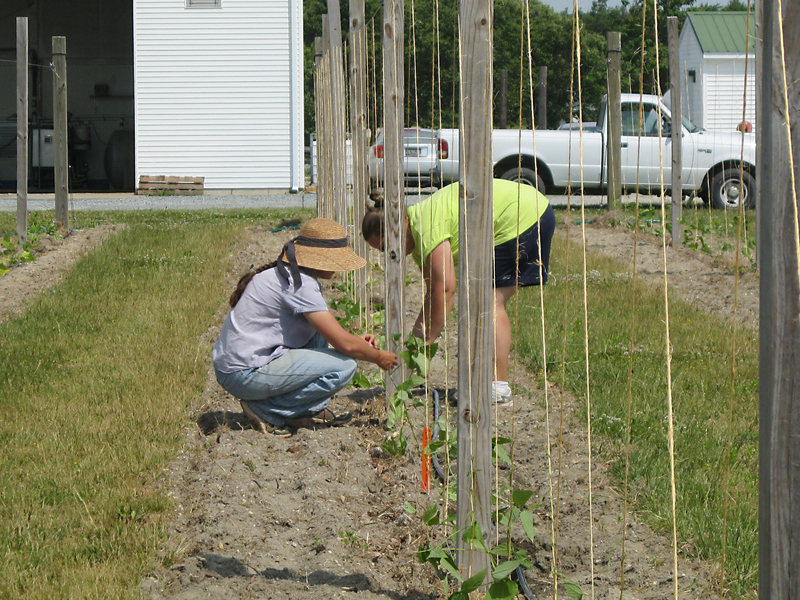It is likely pole lima beans were sprouting out of Delaware's sandy soil before the first Europeans landed here.
Pole limas have been passed down from generation to generation. Many descendants of the original varieties of pole lima beans are still being used by home gardeners and farmers today.
Emmalea Ernest, extension associate for vegetable crops with the University of Delaware, works to cultivate varieties of pole limas at the extension farm outside Georgetown.
"My job is to do applied vegetable research, so with the pole lima beans, I work with breeding lines and collect different varieties in the area," Ernest said, standing beside seven rows of newly planted pole limas.
The seeds were planted in April and nurtured in a greenhouse, before being planted in rows on the farm May 20 and May 23. Once the 2-foot tall young plants were in the ground, lines were run for drip irrigation. This week, Ernest and Heather Baker, a production agriculture student and recent Delaware Tech graduate, started stringing the plants.
Researchers attached tendrils of the plant to twine strung vertically along the rows. The twine will support the plants and keep them upright as they grow. The young plants are situated in batches along the rows and Ernest knows where each variety is placed, so later when the beans are harvested she can record the yields from each group.
"We have a lot of interest from small-scale growers who make money growing and selling pole limas," Ernest said. "I find interesting traits in pole beans that might be useful for producers breeding Fordhook and baby lima beans."
Ernest likes to target specific qualities of pole lima varieties during the growing season, noting how many beans each plant produces and how well the plant survives the weather. These qualities are important to growers and those interested in cross-breeding.
Why pole limas?
Coming from southeastern Pennsylvania, Ernest had only heard of pole lima beans in passing. Arriving at the University of Delaware in 2004, her interest was piqued when she discovered the beans have a long-running legacy in Delaware.
"These beans are very popular here," Ernest said. "I grow them at home and, in my opinion, these are the best tasting ones you can grow."
Delawareans have enjoyed pole beans for so long because of the taste, but also because of the size. Pole lima bean pods dwarf those produced by Fordhook and baby lima varieties. In general, pole lima pods are nearly three times the size of many other varieties. They also grow to be as tall as 6-feet, meaning gardeners and farmers have an easier time picking the pods off the plant.
"Recently I had someone send us a variety that had been in the family for generations, possibly coming down here from Connecticut," Ernest said. "It's a tradition that goes back probably before there were Europeans in Delaware."
In the greenhouse, Ernest shows off pole bean plants growing to the ceiling. These bigger plants were cultivated in March and are now producing large pods of pole limas. Most of the pods have about four beans, but some have up to six.
In the fall when the outside plants are ready for harvest, Ernest and Baker will go through and catalog the number of beans from each variety. Then they will collect the seeds to plant again next year. The harvest is so large, they often end up giving away bushels of pole beans.
"People like pole beans because they are big, but they don't get mealy," Ernest said. "They are larger, but they cook faster and are sweeter."
Growing up in Laurel, she regularly visited her grandparents' farm and always had an interest in agriculture, but before starting at the farm last year, Baker had never tried a pole bean.
After attending Sussex Tech and becoming involved in Future Farmers of America, Baker decided she wanted to continue in agriculture. She received a degree from Delaware Tech this year and plans to attend Delaware State University in the future to continue her agricultural education. For now, she is in her second year working at the University of Delaware cooperative extension farm alongside Ernest.
"I became passionate about farming while with the FFA," Baker said. "I feel like I learn a lot more outside than I do in the classroom."
The beans they give away will likely end up as succotash or in a local favorite - chicken soup with pole beans. Many simply enjoy the beans boiled with butter.
For more information on the project, visit http://ag.udel.edu/extension/vegprogram/ or call 302-856-2585.























































